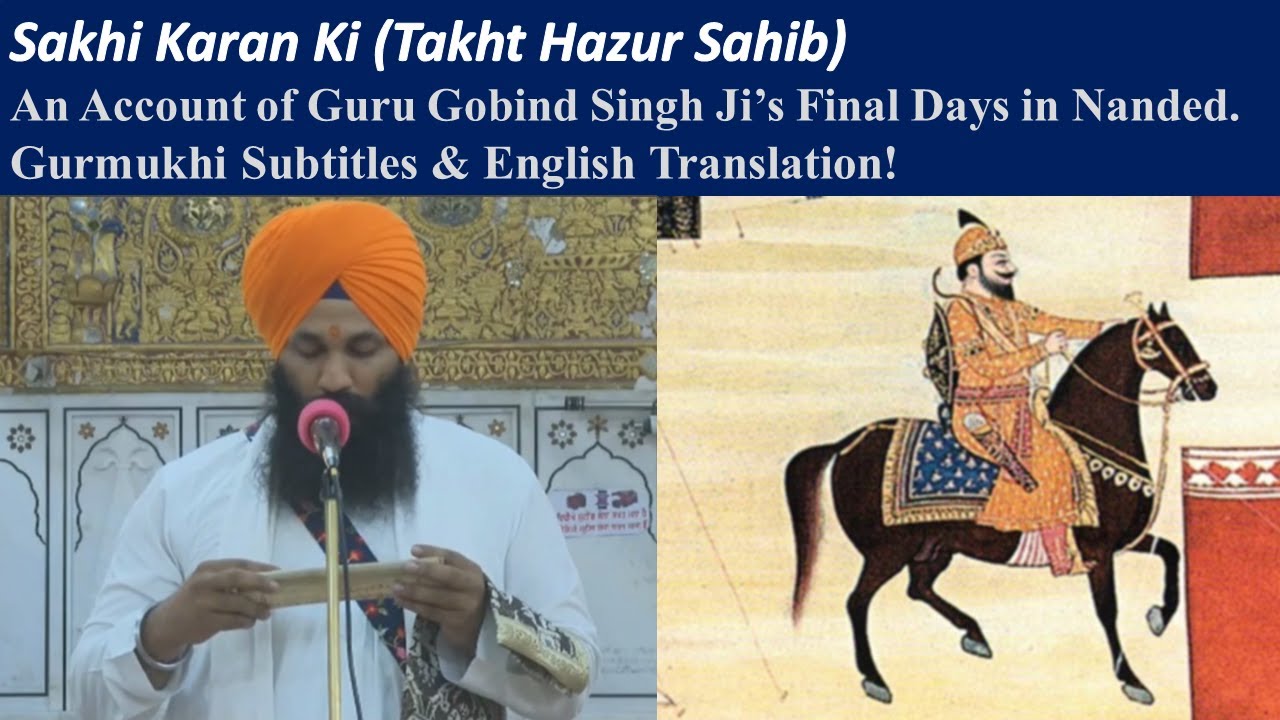This video was put together and uploaded by me on Nov 20, 2021. When I was translating the Sakhi Kaaran Ki for this video, I seemed to have overlooked that it was already translated one year earlier by the Bhai Gurdas Educational Trust and uploaded on their channel on Nov 22, 2020 (Link). Nevertheless, my video presents an alternative translation that I did of the same. I came across the following video (Link) uploaded by Navroop Singh, which inspired me to translate the Sakhi Kaaran Ki and share some historical details. I later read the following post by Navroop Singh (Link) and some social media posts by Bhai Gurdas Educational Trust which helped me add some additional details to my video description later on.
Description (as of May 2023):
Every year, on the annual occasion of the ascension of Sri Guru Gobind Singh Ji, an account held by the Rehrasia family called ‘Sakhi Kaaran Ki’ is read out from an old scroll. The current Rehrasia Singh is Bhai Paramveer Singh, who inherited the Sewa from his father Bhai Binod Singh Ji in 2015. This year (2021), the scroll was read out on Nov 9, 2021, but the exact day varies from year to year due to the way how the traditional Bikrami Sambat calendar works. The date of Guru Gobind Singh Ji’s ascension in the lunar Bikrami Sambat calendar is Katak Sudi 5.
Prior to the colonial era, the Vikrami Samvat (Bikrami Sambat) calendar was the one used for Gurpurbs and celebrations, and the dates we find in Guru Granth Sahib Ji, Dasam Granth and a vast majority of Puratan Sikh literature are written using this calendar. Unlike the English calendar (which is a solar one) the Bikrami Sambat calendar is a lunar calendar and is based on the Moon’s orbit and the phases we see on Earth.
Baba Gurbachan Singh Ji Khalsa of Jatha Bhindra (Damdami Taksal) copied the Sakhi Karan Ki, and had it published in the first 3 pages of his book, Sri Gurmukh Parkash in 1960.
(http://www.panjabdigilib.org/webuser/searches/displayPageContent.jsp?ID=8806&page=21&CategoryID=1&Searched=W3GX )
Bhai Paramveer Singh Ji’s ancestor Bhai Mohan Singh Ji received Amrit from Guru Gobind Singh Ji himself in Burhanpur (Modern-day Madhya Pradesh) and accompanied the master from Burhanpur to Nanded, remaining in his service as his Hazuri Rehrasya Singh. Every evening Bhai Mohan Singh Ji would sing the Rehras Sahib prayer in the Hazuri of Guru Gobind Singh Ji and the Sikh Sangat.
Before Guru Gobind Singh Ji’s ascension in 1708, Bhai Santokh Singh Ji was appointed as the first caretaker (Jathedar) of Hazur Sahib, and was given the duty to take care of the Tap Astan in Abachal Nagar (The Angeetha Sahib – the place from which Guru Gobind Singh Ji ascended). After Bhai Santokh Singh Ji passed away in 1714, Bhai Khushal Singh Ji Nihang became the second Jathedar and caretaker of Hazur Sahib. During this time, Bhai Mohan Singh Ji continued to sing the Rehras every evening, just like how he would in the presence of Guru Gobind Singh Ji, until passing down the duty to his son Bhai Karam Singh Ji in 1717. The Sakhi Kaaran Ki is an account preserved by this family which was presumably recorded by Bhai Mohan Singh Ji or one of his descendants.
Lineage of the Rehrasiya Singhs of Hazur Sahib: https://www.instagram.com/p/CIBRPNps4r8/
In 1962 or 1963, Dr. Trilochan Singh Ji found another similar version titled “Sakhi Karan Ka”, in Lachhmipur, Bihar. This Sakhi Karan Ka was in the form of a journal, detailing the final 20 days of Guru Sahib in Nanded. Although that account shares many similarities with the Sakhi Karan Ki preserved at Hazur Sahib, the two sources significantly differ, showing the fact that they are indeed two different sources, but they tell almost the exact same story. Dr. Trilochan Singh Ji published an English translation of that document in The Sikh Review of October 1963. (http://www.panjabdigilib.org/webuser/searches/displayPageContent.jsp?ID=1257&page=22&CategoryID=2&pagetype=1&Searched=W3GX )
The folios of the actual Gurmukhi manuscript can be viewed on the website of Prof. Anurag Singh linked below:
(https://profanuraagsingh.wordpress.com/2016/04/02/verses-from-dasam-granth-were-recited-on-october-171708-a-d-on-the-occasion-of-antim-ardasa-bhog-ceremony-of-guru-gobind-singh-ji/ )
Keep in mind, there may be some mistakes in the hasty English translation done in this video, but it should be good enough to provide a rough idea of the meanings. Bhul Chuk Maaf Karni!
